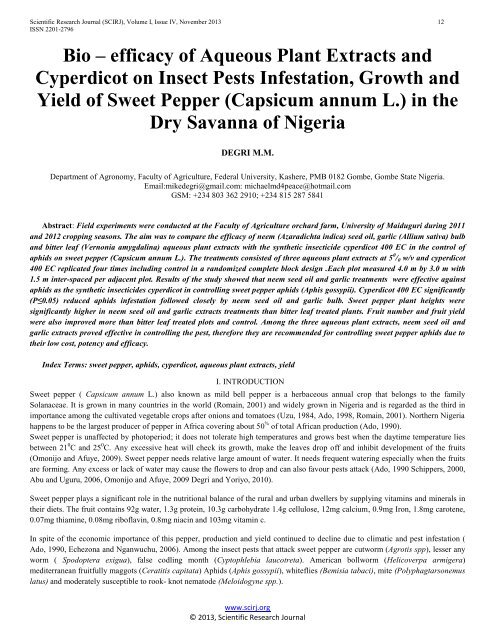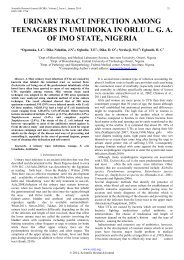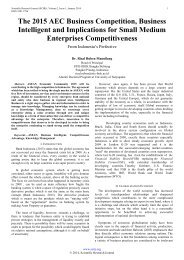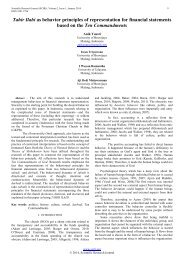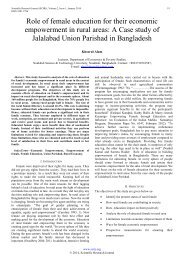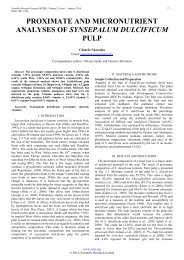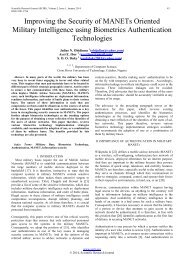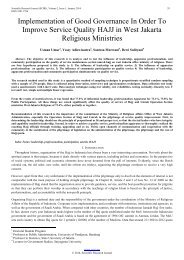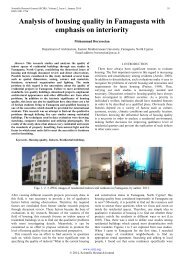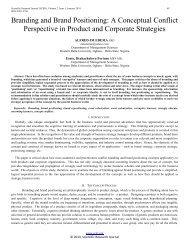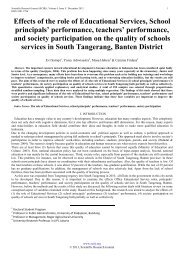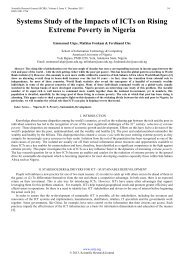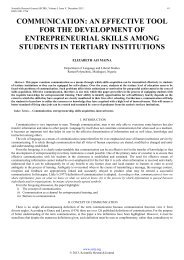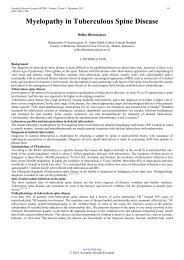Bio – efficacy of Aqueous Plant Extracts and Cyperdicot on Insect Pests Infestation, Growth and Yield of Sweet Pepper (Capsicum annum L.) in the Dry Savanna of Nigeria
Field experiments were conducted at the Faculty of Agriculture orchard farm, University of Maiduguri during 2011 and 2012 cropping seasons. The aim was to compare the efficacy of neem (Azaradichta indica) seed oil, garlic (Allium sativa) bulb and bitter leaf (Vernonia amygdalina) aqueous plant extracts with the synthetic insecticide cyperdicot 400 EC in the control of aphids on sweet pepper (Capsicum annum L.). The treatments consisted of three aqueous plant extracts at 50/0 w/v and cyperdicot 400 EC replicated four times including control in a randomized complete block design .Each plot measured 4.0 m by 3.0 m with 1.5 m inter-spaced per adjacent plot. Results of the study showed that neem seed oil and garlic treatments were effective against aphids as the synthetic insecticides cyperdicot in controlling sweet pepper aphids (Aphis gossypii). Cyperdicot 400 EC significantly (P≤0.05) reduced aphids infestation followed closely by neem seed oil and garlic bulb. Sweet pepper plant heights were significantly higher in neem seed oil and garlic extracts treatments than bitter leaf treated plants. Fruit number and fruit yield were also improved more than bitter leaf treated plots and control. Among the three aqueous plant extracts, neem seed oil and garlic extracts proved effective in controlling the pest, therefore they are recommended for controlling sweet pepper aphids due to their low cost, potency and efficacy.
Field experiments were conducted at the Faculty of Agriculture orchard farm, University of Maiduguri during 2011 and 2012 cropping seasons. The aim was to compare the efficacy of neem (Azaradichta indica) seed oil, garlic (Allium sativa) bulb and bitter leaf (Vernonia amygdalina) aqueous plant extracts with the synthetic insecticide cyperdicot 400 EC in the control of aphids on sweet pepper (Capsicum annum L.). The treatments consisted of three aqueous plant extracts at 50/0 w/v and cyperdicot 400 EC replicated four times including control in a randomized complete block design .Each plot measured 4.0 m by 3.0 m with 1.5 m inter-spaced per adjacent plot. Results of the study showed that neem seed oil and garlic treatments were effective against aphids as the synthetic insecticides cyperdicot in controlling sweet pepper aphids (Aphis gossypii). Cyperdicot 400 EC significantly (P≤0.05) reduced aphids infestation followed closely by neem seed oil and garlic bulb. Sweet pepper plant heights were significantly higher in neem seed oil and garlic extracts treatments than bitter leaf treated plants. Fruit number and fruit yield were also improved more than bitter leaf treated plots and control. Among the three aqueous plant extracts, neem seed oil and garlic extracts proved effective in controlling the pest, therefore they are recommended for controlling sweet pepper aphids due to their low cost, potency and efficacy.
Create successful ePaper yourself
Turn your PDF publications into a flip-book with our unique Google optimized e-Paper software.
Scientific Research Journal (SCIRJ), Volume I, Issue IV, November 2013 12<br />
ISSN 2201-2796<br />
<str<strong>on</strong>g>Bio</str<strong>on</strong>g> <str<strong>on</strong>g>–</str<strong>on</strong>g> <str<strong>on</strong>g>efficacy</str<strong>on</strong>g> <str<strong>on</strong>g>of</str<strong>on</strong>g> <str<strong>on</strong>g>Aqueous</str<strong>on</strong>g> <str<strong>on</strong>g>Plant</str<strong>on</strong>g> <str<strong>on</strong>g>Extracts</str<strong>on</strong>g> <str<strong>on</strong>g>and</str<strong>on</strong>g><br />
<str<strong>on</strong>g>Cyperdicot</str<strong>on</strong>g> <strong>on</strong> <strong>Insect</strong> <strong>Pests</strong> Infestati<strong>on</strong>, <strong>Growth</strong> <str<strong>on</strong>g>and</str<strong>on</strong>g><br />
<strong>Yield</strong> <str<strong>on</strong>g>of</str<strong>on</strong>g> <strong>Sweet</strong> <strong>Pepper</strong> (<strong>Capsicum</strong> <strong>annum</strong> L.) <strong>in</strong> <strong>the</strong><br />
<strong>Dry</strong> <strong>Savanna</strong> <str<strong>on</strong>g>of</str<strong>on</strong>g> <strong>Nigeria</strong><br />
DEGRI M.M.<br />
Department <str<strong>on</strong>g>of</str<strong>on</strong>g> Agr<strong>on</strong>omy, Faculty <str<strong>on</strong>g>of</str<strong>on</strong>g> Agriculture, Federal University, Kashere, PMB 0182 Gombe, Gombe State <strong>Nigeria</strong>.<br />
Email:mikedegri@gmail.com: michaelmd4peace@hotmail.com<br />
GSM: +234 803 362 2910; +234 815 287 5841<br />
Abstract: Field experiments were c<strong>on</strong>ducted at <strong>the</strong> Faculty <str<strong>on</strong>g>of</str<strong>on</strong>g> Agriculture orchard farm, University <str<strong>on</strong>g>of</str<strong>on</strong>g> Maiduguri dur<strong>in</strong>g 2011<br />
<str<strong>on</strong>g>and</str<strong>on</strong>g> 2012 cropp<strong>in</strong>g seas<strong>on</strong>s. The aim was to compare <strong>the</strong> <str<strong>on</strong>g>efficacy</str<strong>on</strong>g> <str<strong>on</strong>g>of</str<strong>on</strong>g> neem (Azaradichta <strong>in</strong>dica) seed oil, garlic (Allium sativa) bulb<br />
<str<strong>on</strong>g>and</str<strong>on</strong>g> bitter leaf (Vern<strong>on</strong>ia amygdal<strong>in</strong>a) aqueous plant extracts with <strong>the</strong> syn<strong>the</strong>tic <strong>in</strong>secticide cyperdicot 400 EC <strong>in</strong> <strong>the</strong> c<strong>on</strong>trol <str<strong>on</strong>g>of</str<strong>on</strong>g><br />
aphids <strong>on</strong> sweet pepper (<strong>Capsicum</strong> <strong>annum</strong> L.). The treatments c<strong>on</strong>sisted <str<strong>on</strong>g>of</str<strong>on</strong>g> three aqueous plant extracts at 5 0 / 0 w/v <str<strong>on</strong>g>and</str<strong>on</strong>g> cyperdicot<br />
400 EC replicated four times <strong>in</strong>clud<strong>in</strong>g c<strong>on</strong>trol <strong>in</strong> a r<str<strong>on</strong>g>and</str<strong>on</strong>g>omized complete block design .Each plot measured 4.0 m by 3.0 m with<br />
1.5 m <strong>in</strong>ter-spaced per adjacent plot. Results <str<strong>on</strong>g>of</str<strong>on</strong>g> <strong>the</strong> study showed that neem seed oil <str<strong>on</strong>g>and</str<strong>on</strong>g> garlic treatments were effective aga<strong>in</strong>st<br />
aphids as <strong>the</strong> syn<strong>the</strong>tic <strong>in</strong>secticides cyperdicot <strong>in</strong> c<strong>on</strong>troll<strong>in</strong>g sweet pepper aphids (Aphis gossypii). <str<strong>on</strong>g>Cyperdicot</str<strong>on</strong>g> 400 EC significantly<br />
(P≤0.05) reduced aphids <strong>in</strong>festati<strong>on</strong> followed closely by neem seed oil <str<strong>on</strong>g>and</str<strong>on</strong>g> garlic bulb. <strong>Sweet</strong> pepper plant heights were<br />
significantly higher <strong>in</strong> neem seed oil <str<strong>on</strong>g>and</str<strong>on</strong>g> garlic extracts treatments than bitter leaf treated plants. Fruit number <str<strong>on</strong>g>and</str<strong>on</strong>g> fruit yield<br />
were also improved more than bitter leaf treated plots <str<strong>on</strong>g>and</str<strong>on</strong>g> c<strong>on</strong>trol. Am<strong>on</strong>g <strong>the</strong> three aqueous plant extracts, neem seed oil <str<strong>on</strong>g>and</str<strong>on</strong>g><br />
garlic extracts proved effective <strong>in</strong> c<strong>on</strong>troll<strong>in</strong>g <strong>the</strong> pest, <strong>the</strong>refore <strong>the</strong>y are recommended for c<strong>on</strong>troll<strong>in</strong>g sweet pepper aphids due to<br />
<strong>the</strong>ir low cost, potency <str<strong>on</strong>g>and</str<strong>on</strong>g> <str<strong>on</strong>g>efficacy</str<strong>on</strong>g>.<br />
Index Terms: sweet pepper, aphids, cyperdicot, aqueous plant extracts, yield<br />
I. INTRODUCTION<br />
<strong>Sweet</strong> pepper ( <strong>Capsicum</strong> <strong>annum</strong> L.) also known as mild bell pepper is a herbaceous annual crop that bel<strong>on</strong>gs to <strong>the</strong> family<br />
Solanaceae. It is grown <strong>in</strong> many countries <strong>in</strong> <strong>the</strong> world (Roma<strong>in</strong>, 2001) <str<strong>on</strong>g>and</str<strong>on</strong>g> widely grown <strong>in</strong> <strong>Nigeria</strong> <str<strong>on</strong>g>and</str<strong>on</strong>g> is regarded as <strong>the</strong> third <strong>in</strong><br />
importance am<strong>on</strong>g <strong>the</strong> cultivated vegetable crops after <strong>on</strong>i<strong>on</strong>s <str<strong>on</strong>g>and</str<strong>on</strong>g> tomatoes (Uzu, 1984, Ado, 1998, Roma<strong>in</strong>, 2001). Nor<strong>the</strong>rn <strong>Nigeria</strong><br />
happens to be <strong>the</strong> largest producer <str<strong>on</strong>g>of</str<strong>on</strong>g> pepper <strong>in</strong> Africa cover<strong>in</strong>g about 50 % <str<strong>on</strong>g>of</str<strong>on</strong>g> total African producti<strong>on</strong> (Ado, 1990).<br />
<strong>Sweet</strong> pepper is unaffected by photoperiod; it does not tolerate high temperatures <str<strong>on</strong>g>and</str<strong>on</strong>g> grows best when <strong>the</strong> daytime temperature lies<br />
between 21 0 C <str<strong>on</strong>g>and</str<strong>on</strong>g> 25 0 C. Any excessive heat will check its growth, make <strong>the</strong> leaves drop <str<strong>on</strong>g>of</str<strong>on</strong>g>f <str<strong>on</strong>g>and</str<strong>on</strong>g> <strong>in</strong>hibit development <str<strong>on</strong>g>of</str<strong>on</strong>g> <strong>the</strong> fruits<br />
(Om<strong>on</strong>ijo <str<strong>on</strong>g>and</str<strong>on</strong>g> Afuye, 2009). <strong>Sweet</strong> pepper needs relative large amount <str<strong>on</strong>g>of</str<strong>on</strong>g> water. It needs frequent water<strong>in</strong>g especially when <strong>the</strong> fruits<br />
are form<strong>in</strong>g. Any excess or lack <str<strong>on</strong>g>of</str<strong>on</strong>g> water may cause <strong>the</strong> flowers to drop <str<strong>on</strong>g>and</str<strong>on</strong>g> can also favour pests attack (Ado, 1990 Schippers, 2000,<br />
Abu <str<strong>on</strong>g>and</str<strong>on</strong>g> Uguru, 2006, Om<strong>on</strong>ijo <str<strong>on</strong>g>and</str<strong>on</strong>g> Afuye, 2009 Degri <str<strong>on</strong>g>and</str<strong>on</strong>g> Yoriyo, 2010).<br />
<strong>Sweet</strong> pepper plays a significant role <strong>in</strong> <strong>the</strong> nutriti<strong>on</strong>al balance <str<strong>on</strong>g>of</str<strong>on</strong>g> <strong>the</strong> rural <str<strong>on</strong>g>and</str<strong>on</strong>g> urban dwellers by supply<strong>in</strong>g vitam<strong>in</strong>s <str<strong>on</strong>g>and</str<strong>on</strong>g> m<strong>in</strong>erals <strong>in</strong><br />
<strong>the</strong>ir diets. The fruit c<strong>on</strong>ta<strong>in</strong>s 92g water, 1.3g prote<strong>in</strong>, 10.3g carbohydrate 1.4g cellulose, 12mg calcium, 0.9mg Ir<strong>on</strong>, 1.8mg carotene,<br />
0.07mg thiam<strong>in</strong>e, 0.08mg rib<str<strong>on</strong>g>of</str<strong>on</strong>g>lav<strong>in</strong>, 0.8mg niac<strong>in</strong> <str<strong>on</strong>g>and</str<strong>on</strong>g> 103mg vitam<strong>in</strong> c.<br />
In spite <str<strong>on</strong>g>of</str<strong>on</strong>g> <strong>the</strong> ec<strong>on</strong>omic importance <str<strong>on</strong>g>of</str<strong>on</strong>g> this pepper, producti<strong>on</strong> <str<strong>on</strong>g>and</str<strong>on</strong>g> yield c<strong>on</strong>t<strong>in</strong>ued to decl<strong>in</strong>e due to climatic <str<strong>on</strong>g>and</str<strong>on</strong>g> pest <strong>in</strong>festati<strong>on</strong> (<br />
Ado, 1990, Echez<strong>on</strong>a <str<strong>on</strong>g>and</str<strong>on</strong>g> Nganwuchu, 2006). Am<strong>on</strong>g <strong>the</strong> <strong>in</strong>sect pests that attack sweet pepper are cutworm (Agrotis spp), lesser any<br />
worm ( Spodoptera exigua), false codl<strong>in</strong>g m<strong>on</strong>th (Cyptophlebia laucotreta). American bollworm (Helicoverpa armigera)<br />
mediterranean fruitfully maggots (Ceratitis capitata) Aphids (Aphis gossypii), whiteflies (Bemisia tabaci), mite (Polyphagtars<strong>on</strong>emus<br />
latus) <str<strong>on</strong>g>and</str<strong>on</strong>g> moderately susceptible to rook- knot nematode (Meloidogyne spp.).<br />
www.scirj.org<br />
© 2013, Scientific Research Journal
Scientific Research Journal (SCIRJ), Volume I, Issue IV, November 2013 13<br />
ISSN 2201-2796<br />
Aphids <str<strong>on</strong>g>and</str<strong>on</strong>g> whiteflies are <strong>the</strong> major <strong>in</strong>sect pest attack<strong>in</strong>g peppers <str<strong>on</strong>g>and</str<strong>on</strong>g> o<strong>the</strong>r vegetable crops grown throughout <strong>Nigeria</strong> <strong>the</strong>y attack <strong>the</strong><br />
crop both <strong>in</strong> <strong>the</strong> nursery <str<strong>on</strong>g>and</str<strong>on</strong>g> ma<strong>in</strong> field (Degri <str<strong>on</strong>g>and</str<strong>on</strong>g> Yoriyo, 2010). Adults <str<strong>on</strong>g>and</str<strong>on</strong>g> nymphs <str<strong>on</strong>g>of</str<strong>on</strong>g> <strong>the</strong>se pests suck <strong>the</strong> sap from tender leaves<br />
<str<strong>on</strong>g>and</str<strong>on</strong>g> grow<strong>in</strong>g shoots, pegs, flowers <str<strong>on</strong>g>and</str<strong>on</strong>g> fruits which lead to loss <strong>in</strong> plant vigor,, stunted growth <str<strong>on</strong>g>and</str<strong>on</strong>g> yield (AVRDC, 1985), Er<strong>in</strong>le,<br />
1989). Ado, 1998, Echez<strong>on</strong>a <str<strong>on</strong>g>and</str<strong>on</strong>g> Nganwuchu, 2006). The <strong>in</strong>festati<strong>on</strong> <str<strong>on</strong>g>of</str<strong>on</strong>g> aphids <str<strong>on</strong>g>and</str<strong>on</strong>g>whiteflies seem to be severe when <strong>the</strong> ra<strong>in</strong> is<br />
scanty. Their populati<strong>on</strong> <strong>in</strong>crease rapidly dur<strong>in</strong>g dry spelt but decl<strong>in</strong>e sharply as <strong>the</strong> ra<strong>in</strong> become heavier <str<strong>on</strong>g>and</str<strong>on</strong>g> more c<strong>on</strong>sistent <str<strong>on</strong>g>and</str<strong>on</strong>g> <strong>the</strong><br />
plant advance <strong>in</strong> age (Onyango, 2002, Om<strong>on</strong>ijo <str<strong>on</strong>g>and</str<strong>on</strong>g> Afuye, 2009).<br />
Applicati<strong>on</strong> <str<strong>on</strong>g>of</str<strong>on</strong>g> pesticides has proved effective but <strong>the</strong> problem <str<strong>on</strong>g>of</str<strong>on</strong>g> envir<strong>on</strong>mental hazards <str<strong>on</strong>g>and</str<strong>on</strong>g> chemical residue <strong>on</strong> fruits has<br />
aggravated <strong>the</strong> problem. Although extensive literature search shows that aphids <str<strong>on</strong>g>and</str<strong>on</strong>g> whiteflies c<strong>on</strong>trol us<strong>in</strong>g syn<strong>the</strong>tic <strong>in</strong>secticides like<br />
karate, cypermethr<strong>in</strong> are available but little or n<strong>on</strong>e has been reported <strong>on</strong> <strong>in</strong>digenous plant extracts <strong>in</strong> <strong>the</strong> study area, hence, <strong>the</strong> present<br />
study was c<strong>on</strong>ducted to <strong>in</strong>dentify promis<strong>in</strong>g <strong>in</strong>digenous plant extracts hav<strong>in</strong>g <strong>the</strong> potential for aphids <str<strong>on</strong>g>and</str<strong>on</strong>g> whiteflies c<strong>on</strong>trol <strong>on</strong> sweet<br />
pepper <strong>in</strong> <strong>the</strong> semi-arid z<strong>on</strong>e <str<strong>on</strong>g>of</str<strong>on</strong>g> <strong>Nigeria</strong>.<br />
II. MATERIALS AND METHODS<br />
Field experiments were carried out at <strong>the</strong> Faculty <str<strong>on</strong>g>of</str<strong>on</strong>g> Agriculture orchard farm, University <str<strong>on</strong>g>of</str<strong>on</strong>g> Maiduguri (11 0 51’N <str<strong>on</strong>g>and</str<strong>on</strong>g> 13 0 05’E, 525<br />
mm mean annual ra<strong>in</strong>fall at <strong>the</strong> dry savanna z<strong>on</strong>e <str<strong>on</strong>g>of</str<strong>on</strong>g> North eastern <strong>Nigeria</strong> dur<strong>in</strong>g 2011 <str<strong>on</strong>g>and</str<strong>on</strong>g> 2012 cropp<strong>in</strong>g seas<strong>on</strong>s (June <str<strong>on</strong>g>–</str<strong>on</strong>g> October) to<br />
compare <strong>the</strong> effects <str<strong>on</strong>g>of</str<strong>on</strong>g> three <strong>in</strong>digenous plant extracts <strong>on</strong> <strong>in</strong>sects pest <strong>in</strong>festati<strong>on</strong>, growth <str<strong>on</strong>g>and</str<strong>on</strong>g> fruit yield <str<strong>on</strong>g>of</str<strong>on</strong>g> sweet pepper. The materials<br />
tested <strong>in</strong>clude <strong>the</strong> extracts <str<strong>on</strong>g>of</str<strong>on</strong>g> neem seed oil (NSO), garlic bulb, bitter leaf <str<strong>on</strong>g>and</str<strong>on</strong>g> c<strong>on</strong>venti<strong>on</strong>al <strong>in</strong>secticides cyperdicot 400EC(a<br />
comb<strong>in</strong>ati<strong>on</strong> <str<strong>on</strong>g>of</str<strong>on</strong>g> cypermethr<strong>in</strong> 250g/l <str<strong>on</strong>g>and</str<strong>on</strong>g> dimethoate 150g/l). The experiments were carried out <strong>in</strong> a r<str<strong>on</strong>g>and</str<strong>on</strong>g>omized complete block<br />
design replicates four times <strong>in</strong>clud<strong>in</strong>g c<strong>on</strong>trols. Each treatment plot measured 4.0 m x 3.0 m (120 m 2 ) <str<strong>on</strong>g>and</str<strong>on</strong>g> was separated by a 2.0 m<br />
alley. The replicati<strong>on</strong>s <str<strong>on</strong>g>and</str<strong>on</strong>g> borders were separated 1.5m apart. <strong>Sweet</strong> pepper seeds were obta<strong>in</strong>ed from Borno State Agricultural<br />
Development programme (BOSADP) <strong>in</strong>put store at Damboa road. The three plant materials tested were collected from plants around<br />
<strong>the</strong> Faculty <str<strong>on</strong>g>and</str<strong>on</strong>g> Research farm while <strong>the</strong> syn<strong>the</strong>tic <strong>in</strong>secticide tested was purchased from an accredited Agrochemical dealer <strong>in</strong> Bama<br />
road Maiduguri. The seeds <str<strong>on</strong>g>of</str<strong>on</strong>g> sweet pepper were first grown <strong>in</strong> nursery beds measur<strong>in</strong>g 6 <str<strong>on</strong>g>–</str<strong>on</strong>g> 8 cm high for 4 weeks before be<strong>in</strong>g<br />
transplanted to <strong>the</strong> experimental field at 60 cm x 40 cm spac<strong>in</strong>g. The experimental field was cleared, ploughed, harrowed <str<strong>on</strong>g>and</str<strong>on</strong>g> subdivided<br />
<strong>in</strong>to plots <str<strong>on</strong>g>of</str<strong>on</strong>g> 4.0 m x 3.0 m before transplant<strong>in</strong>g <strong>the</strong> seedl<strong>in</strong>gs. One seedl<strong>in</strong>g each was transplanted per st<str<strong>on</strong>g>and</str<strong>on</strong>g> after 30 days<br />
when <strong>the</strong>y were about 12 cm high. Fertilizer applicati<strong>on</strong> (NPK 15: 15: 15) as basal dress<strong>in</strong>g at 3, 6 <str<strong>on</strong>g>and</str<strong>on</strong>g> 9 WAT), water<strong>in</strong>g was d<strong>on</strong>e<br />
<strong>on</strong>ce daily <str<strong>on</strong>g>and</str<strong>on</strong>g> weed<strong>in</strong>g was d<strong>on</strong>e manually throughout <strong>the</strong> experiment.<br />
<str<strong>on</strong>g>Aqueous</str<strong>on</strong>g> extracts <str<strong>on</strong>g>of</str<strong>on</strong>g> neem seed oil, garlic bulb <str<strong>on</strong>g>and</str<strong>on</strong>g> bitter leaf were prepared as described by Cobb<strong>in</strong>ah <str<strong>on</strong>g>and</str<strong>on</strong>g> Osei-Uwusu (1988). The<br />
aqueous plant extracts were applied at 5% w/v c<strong>on</strong>centrati<strong>on</strong> while cyperdicot 400EC was applied at 2.0g a.i/ha. Both aqueous plant<br />
extracts <str<strong>on</strong>g>and</str<strong>on</strong>g> cyperdicot were applied us<strong>in</strong>g CP-15 Knapsack sprayer. Each sweet pepper st<str<strong>on</strong>g>and</str<strong>on</strong>g> was sprayed with an <strong>in</strong>secticide that<br />
was re-applied <strong>on</strong>e week after wards when <strong>the</strong> previous applicati<strong>on</strong> waned <str<strong>on</strong>g>of</str<strong>on</strong>g>f.<br />
The number <str<strong>on</strong>g>of</str<strong>on</strong>g> aphids (Aphis gossypii) <str<strong>on</strong>g>and</str<strong>on</strong>g> whiteflies (Bemisia tabaci ) per plant were counted <str<strong>on</strong>g>and</str<strong>on</strong>g> recorded. This was d<strong>on</strong>e<br />
by look<strong>in</strong>g down under <strong>the</strong> leaf surface, shoots, pegs flowers/fruits from 5 r<str<strong>on</strong>g>and</str<strong>on</strong>g>omly selected plants <strong>in</strong> each plot. The r<str<strong>on</strong>g>and</str<strong>on</strong>g>omly<br />
selected sweet pepper plants were also measure us<strong>in</strong>g a graduated ruler to know <strong>the</strong>ir height <strong>in</strong> centimeters <str<strong>on</strong>g>and</str<strong>on</strong>g> recorded <strong>the</strong> number<br />
<str<strong>on</strong>g>of</str<strong>on</strong>g> fruits per plant <str<strong>on</strong>g>and</str<strong>on</strong>g> fresh fruit yield were collected <str<strong>on</strong>g>and</str<strong>on</strong>g> recorded after fruit formati<strong>on</strong> <str<strong>on</strong>g>and</str<strong>on</strong>g> harvest.<br />
The data collected <strong>on</strong> number <str<strong>on</strong>g>of</str<strong>on</strong>g> aphids <str<strong>on</strong>g>and</str<strong>on</strong>g> whiteflies/plant, plant height, number <str<strong>on</strong>g>of</str<strong>on</strong>g> fresh fruits/plant <str<strong>on</strong>g>and</str<strong>on</strong>g> fresh fruit yield were<br />
subjected to analysis <str<strong>on</strong>g>of</str<strong>on</strong>g> variance (ANOVA). Least significant difference (LSD) was used to separate <strong>the</strong> treatment means at 5% level<br />
<str<strong>on</strong>g>of</str<strong>on</strong>g> probability. Duncan multiple test range (DMRT) was used to separate <strong>the</strong> number <str<strong>on</strong>g>of</str<strong>on</strong>g> fresh fruit/plant <str<strong>on</strong>g>and</str<strong>on</strong>g> fresh fruit treatment<br />
means at P< 0.05 level <str<strong>on</strong>g>of</str<strong>on</strong>g> probability.<br />
III. RESULTS AND DISCUSSION<br />
The effect <str<strong>on</strong>g>of</str<strong>on</strong>g> <strong>the</strong> aqueous plant extracts <str<strong>on</strong>g>and</str<strong>on</strong>g> cyperdicot applicati<strong>on</strong> <strong>on</strong> aphids <str<strong>on</strong>g>and</str<strong>on</strong>g> whiteflies populati<strong>on</strong> <strong>on</strong> sweet pepper plants taken<br />
at different stages <str<strong>on</strong>g>of</str<strong>on</strong>g> <strong>the</strong> plant is presented <strong>in</strong> Table 1.<br />
The result showed that <strong>the</strong> populati<strong>on</strong> <str<strong>on</strong>g>of</str<strong>on</strong>g> <strong>the</strong> aphids <str<strong>on</strong>g>and</str<strong>on</strong>g> whiteflies <strong>on</strong> treatment plots were significantly different (P < 0.05) from <strong>the</strong><br />
untreated c<strong>on</strong>trol. Neem seed oil (NSO), garlic bulb <str<strong>on</strong>g>and</str<strong>on</strong>g> cyperdicot treated plots had lower number <str<strong>on</strong>g>of</str<strong>on</strong>g> aphids <str<strong>on</strong>g>and</str<strong>on</strong>g> whiteflies <strong>in</strong> both<br />
cropp<strong>in</strong>g seas<strong>on</strong>s than bitter leaf treated plots while untreated c<strong>on</strong>trol had significantly <strong>the</strong> highest aphids <str<strong>on</strong>g>and</str<strong>on</strong>g> whiteflies populati<strong>on</strong><br />
dur<strong>in</strong>g <strong>the</strong> same period. The significantly lower aphids <str<strong>on</strong>g>and</str<strong>on</strong>g> whiteflies count recorded <strong>in</strong> neem seed oil, garlic <str<strong>on</strong>g>and</str<strong>on</strong>g> cyperdicot treated<br />
plots <strong>in</strong>dicates that <strong>the</strong>se two aqueous plant extracts (neem seed oil <str<strong>on</strong>g>and</str<strong>on</strong>g> garlic bulb) were as effective as <strong>the</strong> syn<strong>the</strong>tic <strong>in</strong>secticide,<br />
www.scirj.org<br />
© 2013, Scientific Research Journal
Scientific Research Journal (SCIRJ), Volume I, Issue IV, November 2013 14<br />
ISSN 2201-2796<br />
cyperdicot aga<strong>in</strong>st <strong>the</strong> pests.The two aqueous plant extracts significantly reduce <strong>the</strong> populati<strong>on</strong> <str<strong>on</strong>g>of</str<strong>on</strong>g> <strong>the</strong> aphids <str<strong>on</strong>g>and</str<strong>on</strong>g> whiteflies <strong>on</strong> <strong>the</strong><br />
plant hence, <strong>the</strong> reducti<strong>on</strong> <strong>in</strong> <strong>the</strong> suck<strong>in</strong>g activities <str<strong>on</strong>g>of</str<strong>on</strong>g> both <strong>the</strong> adults <str<strong>on</strong>g>and</str<strong>on</strong>g> nymphs <str<strong>on</strong>g>of</str<strong>on</strong>g> <strong>the</strong> pests.This has also significantly reduced <strong>the</strong><br />
loss <strong>in</strong> vigour <str<strong>on</strong>g>and</str<strong>on</strong>g> stunted growth <str<strong>on</strong>g>of</str<strong>on</strong>g> <strong>the</strong> plant (Degri <str<strong>on</strong>g>and</str<strong>on</strong>g> Yoriyo, 2010). The lower count <str<strong>on</strong>g>of</str<strong>on</strong>g> aphids <str<strong>on</strong>g>and</str<strong>on</strong>g> whiteflies recorded under <strong>the</strong><br />
two plant extracts implies that <strong>the</strong>se plant extracts posses active <strong>in</strong>gredients that are know to have repellent, antifeedant <str<strong>on</strong>g>and</str<strong>on</strong>g> phagodeterrent<br />
effects aga<strong>in</strong>st <strong>the</strong> aphids <str<strong>on</strong>g>and</str<strong>on</strong>g> whiteflies (Degri <str<strong>on</strong>g>and</str<strong>on</strong>g> Yoriyo, 2010, Degri et al., 2012).<br />
Table 1: Effect <str<strong>on</strong>g>of</str<strong>on</strong>g> aqueous plant extracts applicati<strong>on</strong> <strong>on</strong> aphids <str<strong>on</strong>g>and</str<strong>on</strong>g> whiteflies <str<strong>on</strong>g>of</str<strong>on</strong>g> sweet pepper.<br />
Treatment<br />
Aphids <str<strong>on</strong>g>and</str<strong>on</strong>g> whiteflies count/ plant<br />
2011 2012<br />
Neem seed oil (Azadirachta sp) 0.4 * 0.3 ** 0.5 * 0.5 **<br />
Garlic bulb (Allium sativum) 0.5 0.5 0.3 0.4<br />
<str<strong>on</strong>g>Cyperdicot</str<strong>on</strong>g> 400EC 0.3 0.2 0.2 0.1<br />
Bitter leaf (Vern<strong>on</strong>ia amygdal<strong>in</strong>a) 1.0 1.0 2.0 3.0<br />
C<strong>on</strong>trol 2.3 3.0 4.0 6.0<br />
SE + 0.51 0.62 0.82 0.84<br />
LSD (0.05) 1.10 1.30 1.56 1.58<br />
*Aphids<br />
** whiteflies<br />
Table 2 shows <strong>the</strong> effect <str<strong>on</strong>g>of</str<strong>on</strong>g> aqueous plant extracts applicati<strong>on</strong> <strong>on</strong> sweet pepper plant height dur<strong>in</strong>g <strong>the</strong> two- year study period. Neem<br />
seed oil, garlic bulb competed favourably with <strong>the</strong> syn<strong>the</strong>tic <strong>in</strong>secticides cyperdicot <strong>in</strong> improv<strong>in</strong>g <strong>the</strong> growth <str<strong>on</strong>g>of</str<strong>on</strong>g> <strong>the</strong> plant while c<strong>on</strong>trol<br />
treatment did not had <strong>the</strong> opportunity to grow due to aphids <str<strong>on</strong>g>and</str<strong>on</strong>g> whiteflies activities dur<strong>in</strong>g <strong>the</strong> study period. Bitter leaf extract had<br />
moderate plant height when compared with <strong>the</strong> o<strong>the</strong>r two plant extracts. The high plant height recorded under cyperdicot, neem seed<br />
oil <str<strong>on</strong>g>and</str<strong>on</strong>g> garlic bulb was probably due to <strong>the</strong>ir effectiveness aga<strong>in</strong>st <strong>the</strong> aphids <str<strong>on</strong>g>and</str<strong>on</strong>g> whiteflies which must have reduced <strong>the</strong>ir piec<strong>in</strong>g<br />
<str<strong>on</strong>g>and</str<strong>on</strong>g> suck<strong>in</strong>g activities <strong>on</strong> <strong>the</strong> crop. This view agrees with <strong>the</strong> report <str<strong>on</strong>g>of</str<strong>on</strong>g> NRI (1996) <str<strong>on</strong>g>and</str<strong>on</strong>g> Ado (1990). The moderate <str<strong>on</strong>g>and</str<strong>on</strong>g> lower plant<br />
heights recorded under bitter leaf <str<strong>on</strong>g>and</str<strong>on</strong>g> c<strong>on</strong>trol treated plots <strong>in</strong> both years were due to serious pierc<strong>in</strong>g <str<strong>on</strong>g>and</str<strong>on</strong>g> suck<strong>in</strong>g activities <str<strong>on</strong>g>of</str<strong>on</strong>g> <strong>the</strong><br />
pests which caused <strong>the</strong> stunted growth <strong>in</strong> <strong>the</strong> plant <str<strong>on</strong>g>and</str<strong>on</strong>g> possible subsequent entry <str<strong>on</strong>g>of</str<strong>on</strong>g> pathogen <strong>in</strong>to <strong>the</strong> plant <str<strong>on</strong>g>and</str<strong>on</strong>g> <strong>the</strong>ir transmissi<strong>on</strong><br />
across <strong>the</strong> plant parts result<strong>in</strong>g to serious reducti<strong>on</strong> <strong>in</strong> photosyn<strong>the</strong>tic activity <str<strong>on</strong>g>and</str<strong>on</strong>g> yield. This f<strong>in</strong>d<strong>in</strong>g agrees with <strong>the</strong> report <str<strong>on</strong>g>of</str<strong>on</strong>g> Degri<br />
<str<strong>on</strong>g>and</str<strong>on</strong>g> Yoriyo (2010). This result <strong>in</strong>dicate that bitter leaf has little pesticidal potential for c<strong>on</strong>troll<strong>in</strong>g aphids <str<strong>on</strong>g>and</str<strong>on</strong>g> whiteflies <strong>on</strong> peppers<br />
<str<strong>on</strong>g>and</str<strong>on</strong>g> it cannot compete favourably with cyperdicot <strong>in</strong> manag<strong>in</strong>g <strong>the</strong>m (Isman,2006 Fuglie, 1998).<br />
Table 2: Effect <str<strong>on</strong>g>of</str<strong>on</strong>g> aqueous plant extracts applicati<strong>on</strong> <strong>on</strong> sweet peppers plant height<br />
Treatment<br />
<str<strong>on</strong>g>Plant</str<strong>on</strong>g> height (cm)<br />
2011 2012<br />
Neem seed oil 29.3 29.1<br />
Garlic bulb 28.0 28.3<br />
<str<strong>on</strong>g>Cyperdicot</str<strong>on</strong>g> 400EC 30.1 29.89<br />
Bitter leaf 20.6 21.2<br />
C<strong>on</strong>trol 16.3 16.1<br />
www.scirj.org<br />
© 2013, Scientific Research Journal
Scientific Research Journal (SCIRJ), Volume I, Issue IV, November 2013 15<br />
ISSN 2201-2796<br />
SE+ 2.78 2.89<br />
LSD (0.05) 5.50 5.80<br />
The results <str<strong>on</strong>g>of</str<strong>on</strong>g> <strong>the</strong> effect <str<strong>on</strong>g>of</str<strong>on</strong>g> aqueous plant extracts <str<strong>on</strong>g>and</str<strong>on</strong>g> cyperdicot applicati<strong>on</strong> <strong>on</strong> number <str<strong>on</strong>g>of</str<strong>on</strong>g> fruits per plant are presented <strong>in</strong> Table 3.<br />
The results show that neem seed oil <str<strong>on</strong>g>and</str<strong>on</strong>g> garlic bulb had significantly ( p
Scientific Research Journal (SCIRJ), Volume I, Issue IV, November 2013 16<br />
ISSN 2201-2796<br />
Figures followed by <strong>the</strong> same superscripts are not significantly different at P< 0.05 accord<strong>in</strong>g to DMRT.<br />
IV. CONCLUSION<br />
The study showed that aqueous plant extracts (5% w/v c<strong>on</strong>centrati<strong>on</strong>) <str<strong>on</strong>g>of</str<strong>on</strong>g> neem seed oil <str<strong>on</strong>g>and</str<strong>on</strong>g> garlic bulb applied at <strong>on</strong>e week <strong>in</strong>terval<br />
were found to be effective aga<strong>in</strong>st pierc<strong>in</strong>g <str<strong>on</strong>g>and</str<strong>on</strong>g> suck<strong>in</strong>g Aphis gossypii <str<strong>on</strong>g>and</str<strong>on</strong>g> Bemisia tabaci <str<strong>on</strong>g>and</str<strong>on</strong>g> were at par with cyperdicot 400EC.<br />
The applicati<strong>on</strong> <str<strong>on</strong>g>of</str<strong>on</strong>g> <strong>the</strong> two extracts reduced <strong>the</strong>ir populati<strong>on</strong> <strong>on</strong> sweet pepper, improved <strong>the</strong> plant height <str<strong>on</strong>g>and</str<strong>on</strong>g> number <str<strong>on</strong>g>of</str<strong>on</strong>g> fruits/plant<br />
<str<strong>on</strong>g>and</str<strong>on</strong>g> c<strong>on</strong>sequently improved <strong>the</strong> fruit yield <str<strong>on</strong>g>and</str<strong>on</strong>g> quality. It is <strong>the</strong>refore recommended that sweet pepper producers <strong>in</strong> <strong>the</strong> dry savanna<br />
regi<strong>on</strong> adopt <strong>the</strong> applicati<strong>on</strong> <str<strong>on</strong>g>of</str<strong>on</strong>g> neem seed oil <str<strong>on</strong>g>and</str<strong>on</strong>g> garlic bulb extracts at <strong>on</strong>e week spray <strong>in</strong>terval to improve sweet pepper growth <str<strong>on</strong>g>and</str<strong>on</strong>g><br />
fruit producti<strong>on</strong>.<br />
REFERENCES<br />
[1] Abu, N.E. <str<strong>on</strong>g>and</str<strong>on</strong>g> Uguru, M.J (2006). Everluati<strong>on</strong> <str<strong>on</strong>g>of</str<strong>on</strong>g> genetic variati<strong>on</strong> <strong>in</strong> growth <str<strong>on</strong>g>and</str<strong>on</strong>g> yield comp<strong>on</strong>ents <str<strong>on</strong>g>of</str<strong>on</strong>g> aromatic peppers l<strong>in</strong>es <strong>in</strong> <strong>the</strong> derived<br />
savanna ecology <str<strong>on</strong>g>of</str<strong>on</strong>g> <strong>Nigeria</strong> Agro-science 5(1). 1-7<br />
[2] Ado. S.G. (1990). peppers producti<strong>on</strong> guide extensi<strong>on</strong> publicati<strong>on</strong> submitted to <strong>the</strong> Horticultural crop research programme, IAR <strong>Savanna</strong>, zaria<br />
12pp<br />
[3] Ado, S.G. (1998). Evaluati<strong>on</strong> <str<strong>on</strong>g>of</str<strong>on</strong>g> capsi<strong>on</strong> <strong>in</strong> Nigeia PGRCLE. Newsletter 17:16-17<br />
[4] AVRDC, (1985). progress report <str<strong>on</strong>g>of</str<strong>on</strong>g> 1985 Asian vegetable research <str<strong>on</strong>g>and</str<strong>on</strong>g> Development centre, shuahua, Taiwan, 144pp<br />
[5] AVRDC, (2002). Integrated <strong>in</strong>sect pest <str<strong>on</strong>g>and</str<strong>on</strong>g> disease management for envir<strong>on</strong>ment friendly producti<strong>on</strong> <str<strong>on</strong>g>of</str<strong>on</strong>g> safe vegetables, www.avde.org/pepper<br />
<strong>in</strong>htnl Cob<strong>in</strong>nah, J.R. <str<strong>on</strong>g>and</str<strong>on</strong>g> Osei-Owusu, K. (1988). Effects <str<strong>on</strong>g>of</str<strong>on</strong>g> neem seed extract <strong>on</strong> <strong>in</strong>sect pest <str<strong>on</strong>g>of</str<strong>on</strong>g> eggplant <str<strong>on</strong>g>and</str<strong>on</strong>g> cowpea. <strong>Insect</strong> Science <str<strong>on</strong>g>and</str<strong>on</strong>g> its<br />
Applicati<strong>on</strong> 9: 601 -607.<br />
[6] Degri, M.M. <str<strong>on</strong>g>and</str<strong>on</strong>g> Yoriyo, K.P. (2010) Efficacy <str<strong>on</strong>g>of</str<strong>on</strong>g> three plant extracts for <strong>the</strong> c<strong>on</strong>trol <str<strong>on</strong>g>of</str<strong>on</strong>g> aphids (Aphis gossypii Glov) (Homoptera; Aphididae)<br />
<strong>on</strong> sweet peppers (<strong>Capsicum</strong> <strong>annum</strong> L.) (Solanaceae) <strong>in</strong> <strong>Nigeria</strong> Sudan <strong>Savanna</strong>, Internati<strong>on</strong>al Journal <str<strong>on</strong>g>of</str<strong>on</strong>g> Food <str<strong>on</strong>g>and</str<strong>on</strong>g> Agricultural Research 7 (1):<br />
256 -262<br />
[7] Each z<strong>on</strong>a, B.C. <str<strong>on</strong>g>and</str<strong>on</strong>g> Nganwuchu, O.G. (2006). Poultry manure applicati<strong>on</strong> <str<strong>on</strong>g>and</str<strong>on</strong>g> varietal effects f pepper (capsicum SPP.) <strong>on</strong> <strong>in</strong>sect pest <str<strong>on</strong>g>and</str<strong>on</strong>g><br />
disease <strong>in</strong> <strong>the</strong> humid-tropical envir<strong>on</strong>ment. Agro-science 5(2): 49-58<br />
[8] Er<strong>in</strong>le, I.D. (1989) present status <str<strong>on</strong>g>and</str<strong>on</strong>g> prospects for <strong>in</strong>creased producti<strong>on</strong> <str<strong>on</strong>g>of</str<strong>on</strong>g> tomato <str<strong>on</strong>g>and</str<strong>on</strong>g> pepper <strong>in</strong> <strong>the</strong> tropics. Proc. Int.sym <strong>in</strong>tegrated<br />
management practices, AVRDC, Shuahua, Taiwan 536 <str<strong>on</strong>g>–</str<strong>on</strong>g> 548<br />
[9] Fuglie, F.J. (1998). Produc<strong>in</strong>g food without pesticides local soluti<strong>on</strong> to crop pest c<strong>on</strong>trol <strong>in</strong> west Africa, CTA, <strong>the</strong> nor<strong>the</strong>rl<str<strong>on</strong>g>and</str<strong>on</strong>g>s, 158pp<br />
[10] Isman, M.B. (2006). Botanical <strong>in</strong>secticides, daterrents <str<strong>on</strong>g>and</str<strong>on</strong>g> repellents <strong>in</strong> modern Agriculture <str<strong>on</strong>g>and</str<strong>on</strong>g> an <strong>in</strong>creas<strong>in</strong>gly regulated world. Ann. Rev.<br />
Emto 51:45 -66.<br />
[11] NRI, ( Natural resources <strong>in</strong>stitute), (1996). A guide to <strong>in</strong>sect pests <str<strong>on</strong>g>of</str<strong>on</strong>g> <strong>Nigeria</strong>n crops. Identificati<strong>on</strong>, biology <str<strong>on</strong>g>and</str<strong>on</strong>g> c<strong>on</strong>trol. UK: Overseas<br />
Development Adm<strong>in</strong>istrati<strong>on</strong>. 240pp<br />
[12] Onyango, M.O.A. (2002). African <strong>in</strong>digenous vegetables <str<strong>on</strong>g>–</str<strong>on</strong>g> opportunities <str<strong>on</strong>g>and</str<strong>on</strong>g> c<strong>on</strong>stra<strong>in</strong>ts , <strong>in</strong> proceed<strong>in</strong>g <str<strong>on</strong>g>of</str<strong>on</strong>g> <strong>the</strong> Horticulture sem<strong>in</strong>ar <strong>on</strong><br />
susta<strong>in</strong>able Horticultural producti<strong>on</strong> <strong>in</strong> <strong>the</strong> Tropics, Jomo Kenya, Kenya, Pp 360 <str<strong>on</strong>g>–</str<strong>on</strong>g> 365<br />
[13] Om<strong>on</strong>ijo, A.G. <str<strong>on</strong>g>and</str<strong>on</strong>g> Afuye, G.G. (2009). Envir<strong>on</strong>mental <str<strong>on</strong>g>and</str<strong>on</strong>g> climatic factors <strong>in</strong> different types <str<strong>on</strong>g>of</str<strong>on</strong>g> pepper fruit yield <strong>in</strong> <strong>the</strong> <strong>Nigeria</strong>n Gu<strong>in</strong>ea<br />
<strong>Savanna</strong>.Internati<strong>on</strong>al Journal <str<strong>on</strong>g>of</str<strong>on</strong>g> Crop Sc<strong>in</strong>ce 1 (1): 59 <str<strong>on</strong>g>–</str<strong>on</strong>g> 63<br />
[14] Roama<strong>in</strong>, H.R. (2001). Crop producti<strong>on</strong> <strong>in</strong> Tropical Africa, DGIC, Brussels, Belgium 462 -467<br />
[15] Degri, M.M, Ayuba, M.M. <str<strong>on</strong>g>and</str<strong>on</strong>g> Yoriyo, K.P. (2012). <str<strong>on</strong>g>Bio</str<strong>on</strong>g> <str<strong>on</strong>g>–</str<strong>on</strong>g> <str<strong>on</strong>g>efficacy</str<strong>on</strong>g> <str<strong>on</strong>g>of</str<strong>on</strong>g> some aqueous plant extracts <str<strong>on</strong>g>and</str<strong>on</strong>g> cyromaz<strong>in</strong>e (trigard 169) <strong>in</strong> <strong>the</strong><br />
management <str<strong>on</strong>g>of</str<strong>on</strong>g> leaf m<strong>in</strong>er (Liri<strong>on</strong>y za sp) <strong>on</strong> Eggplants <strong>in</strong> <strong>the</strong> Nor<strong>the</strong>rn Gu<strong>in</strong>ea <strong>Savanna</strong> <str<strong>on</strong>g>of</str<strong>on</strong>g> <strong>Nigeria</strong>. <strong>Nigeria</strong>n Journal <str<strong>on</strong>g>of</str<strong>on</strong>g> Experimental <str<strong>on</strong>g>and</str<strong>on</strong>g><br />
Applied <str<strong>on</strong>g>Bio</str<strong>on</strong>g>logy 13 (2): 125 <str<strong>on</strong>g>–</str<strong>on</strong>g> 130 (2012).<br />
[16] Schippers, R.R. (200). African I <strong>in</strong>digenous vegetables chatham, UK, 214Pp<br />
[17] Stoll, G. (2001). Natural crop producti<strong>on</strong> <strong>in</strong> <strong>the</strong> Tropics. Tropical<br />
[18] Agroecology, magrat verlag, Germany. 188Pp.<br />
[19] Uzo, J.O. (1984). The genetics <str<strong>on</strong>g>of</str<strong>on</strong>g> <strong>on</strong> ve<strong>in</strong> b<str<strong>on</strong>g>and</str<strong>on</strong>g><strong>in</strong>g <strong>in</strong> Aromatic peppers (Capsium <strong>annum</strong> L.).<br />
[20] Societia Horticulture 22: 201 <str<strong>on</strong>g>–</str<strong>on</strong>g> 205<br />
www.scirj.org<br />
© 2013, Scientific Research Journal


